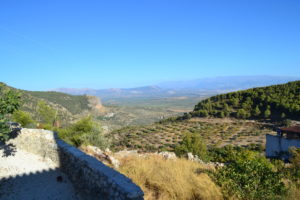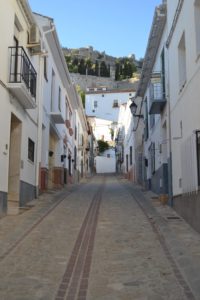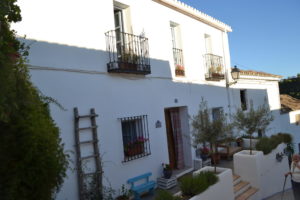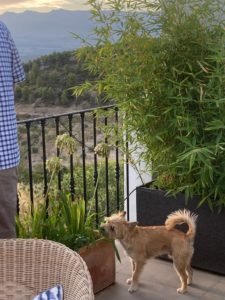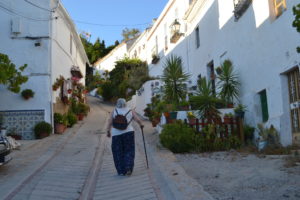8 a.m. on a Wednesday and the bedroom curtains are pulled back to reveal a typical British December morning, grey and overcast. The hills to the south west are slowly disappearing behind a curtain of fine drizzle which is slowly marching towards me and to really load the icing onto the cake the temperature is forecast not to reach anywhere near double figures. The mind immediately races back to early September and the anticipation of waiting to board our silver (well white with a touch of orange) bird at Manchester airport to take us to Malaga Spain and then by a hire car onto a small village called Moclin, north west of Granada, and a much postponed holiday. Finally the success of the COVID vaccination program has led to the relaxation of the nation’s travel restrictions allowing us to travel abroad with minimal inconvenience if, hopefully, all our documents present and correct.
Landing on foreign shores the old routine slowly comes back to us and after a brief hunt for our car hire company we are off following the detailed travel instructions, provided by Ian and Andrew, to our final destination some 140 Km away. It was these detailed instructions that hid a school boy error on our part, in our haste to get going we had forgotten to check that the Sat-Nav in the car was set to English, something that would come to haunt us later on. The road to Granada is a quite recently constructed motorway and as such is not the most exciting of drives, but efficient given the distance we had to travel.
On arrival at the outskirts of Granada we leave the motorway and take a ‘normal’ single carriageway road heading for Cordoba and Pinos Puente. Here an ominous note in our instructions warned us not to follow the signs for Moclin when we reach Pinos Puente, at least not on our first visit, leaving a big question mark in our minds as to where exactly we are headed. We sail on to Puerto Lope and this time do follow the signs and start climbing up a steep, winding, narrow road and wonder what the other road must have been like. Up we climb, past olive groves and small farms until after 4.5 Km we pass a bus stop and see the sign for Moclin and beyond it the village overshadowed by the ruins of a castle (interesting start).
Moclin is a small, sleepy village some 35Km NW of Granada, resting underneath the ruined castle atop a hill some 3500ft high, with narrow, steep streets and white-washed houses. But Moclin is one of those places like, Towton, Mont St Jean and Borodino, where its historic importance is lost to the common narrative and confined to the history pages. Because of this holidays in Moclin and surrounding area are unlikely to be found in conventional holiday brochures and you need to know that the holidays are there before you can book one. Luckily there seems to be an ‘underground’ network of information providers where this type of location is well known. My introduction to this tranquil place was through the Silver Travel Advisor web site which, in turn, led me to Ian and Andrew at Casa Higueras.
Following the directions we make our way through the village (after a couple of wrong turns), down narrow, and sometimes, steep streets until we reach a dead end with only one way to go, up the steep Calle Amargura on which the Casa Higueras resides. I had, of course, made the mistake of stopping at the bottom of the street, so lots of wheel spinning, burning of rubber and black marks are required to get us up to the top and find a place to park and unload, because the parking spaces marked on our map were all full. The sound of my attempts to imitate one of the Top Gear team announces our arrival to our hosts and Ian comes to meet us and lead us to our destination.
Casa Higueras is a lovingly restored traditional two storey, double fronted, white-washed terraced house halfway up the street on the edge of the village. We enter through a sturdy wooden door into a tile floored hallway with a door on the left to a guest bedroom with shower room/toilet, the archway ahead leads to the combined dining room/kitchen. Off the kitchen is: a lounge/TV room to the front; double doors to a patio area and a stairway to the upper floor, to which we are invited to have tea on the terrace upstairs once we’ve settled in.
Our room was traditionally Spanish, white painted plaster with outcrops of stone to show the traditional building materials. A king size bed, a wardrobe/storage shelves construction built from painted stone/concrete slabs with a traditional curtain to hide the contents. Set into the eternal wall is a small glassless window with iron bars (rejas) and a sturdy wooden shutter. Opposite is the door to the shower room which refreshingly, when compared to your average hotel, is roughly the same size as the bedroom. A walk-in shower, toilet and a large sink area (ensuring that there should be no congestion in a morning) make up the usual facilities along with a shelf of book and numerous small drawings and paintings decorating the walls which turn out to be examples of our hosts’ work. A pleasant surprise is the ceiling which consists of open beams made from tree trunks, 6” to 8” in diameter spaced about 18” apart, but refreshingly not uniform. Above the beams the upper floor is built from what look like hand sawn rough-cut planks, again not of uniform width reinforcing the reliance on traditional skills in the renovation and really enveloping you to traditional Spanish village home when lying in bed looking up.
Each side of the bed are small sturdy bedside cabinets with a drawer and cupboard below. Interesting reading matter was provided, the usual guide books and one that really caught the attention, ‘South from Granada’ by Gerald Brenan. The book of the reminiscences of a WW1 soldier living in the remote Spanish village of Yegen in the foothills of the Sierra Nevada mountain range on and off between 1920 and 1934 documenting the life, folklore, customs and festivals in the years before the Spanish civil war. I started reading this before bed and got so enthralled that I had to buy a copy when I got home so that I could finish it.
With the initial look around and summary unpacking completed we take up the invitation for tea on the terrace. Taking stairs up to the first floor to an open sitting area with access to the second guest bedroom, the host’s quarters and a double door leading to the terrace and garden. Here breakfast would be indulged in the morning, but for now it is tea and some secret weapons, home-made banana loaf, and Alfie the ubiquitous bundle of wagging, licking friendliness and sometime fearless protector. Sitting enjoying our tea we begin to marvel at what is spread out before us, one of the most spectacular views around. Because the house is at the edge of the village, it has an uninterrupted view over the valley to Granada some 20 miles away to the south east under the towering Sierra Nevada mountain range beyond. Now this looks really good in the afternoon basking in the glow of the setting sun.
After tea we resort to explore the village and get our bearings. Down narrow streets flanked by white-washed houses, some with beautifully tiled panels next to the door breaking up the monotony of the white paint. Some houses also had first floor Juliet balconies to add some individuality and possibly a degree of ‘one-up-man-ship’. All the houses and streets are quiet except for the occasional called request from deep inside a house by as we pass, or some faint music from a radio/TV program. Descending into the village square we pass the civic building (town hall) on the left replete with flags and a map of the area, opposite is the corner shop (which we never did see open, even though we were assured it did) and a tavern which was open, a fact noted for future reference. We continue up the street and reach the entrance to the village after encountering a couple of hostels, a part time police station and some closed casualties of the pandemic.
We decide to call it a day and start back, but all this walking is thirsty work so we stop at the tavern in the square for a beer, a local brew called Alhambra which is rather good. A conversation somehow is started up with an elderly local sitting on the next table finishing his beer and his roll-your-own cigarette. With me speaking English, with hopeful gestures, and our new friend just speaking Spanish again with hopefully helpful gestures. Lots of words were exchanged, but none the same, or seemingly understood. All was resolved when it turned out that he just wanted us to move onto the table he was vacating so that we could get some shade from the sun. Friendly locals!
Next morning we rise early and head upstairs for breakfast on the terrace and we were greeted with the marvellous sight of the sun rising above the Sierra Nevada in front of us, a view that is truly something else. The benefit of being so high up really shows its advantage now, Granada is some 25Km away to the south east with the fertile valley in between with ancient olive trees set in terraces on adjoining hillsides. The occasional con trails of planes on route to somewhere paint white lines across the sky joining together the high clouds like precursory aerial spider’s webs.
Tearing ourselves away from the vista our gaze is arrested by the breakfast that is spread out before us and which looks sumptuous : freshly brewed coffee; fresh orange juice; fresh fruit; yogurt; honey; Pan con Tomate (grated tomato on toast); Pan de Aceite (Spanish olive oil bread); granola; home-made fruit preserves (my favourite was the plum compote); and the plato fuerte (pièce de résistance) is the home made lemon short bread that just disappeared in the mouth once you bit into it. What with this and the view it was a wrench to move away, but duty calls and we must see the sights.
For the next two days we were off early to view the delights of Granada and the Alhambra, returning late from Granada to witness the sun set and a beer on the terrace before a shower and bed. Yes it’s a holiday and we’re in bed before midnight!
On our last night at Moclin (Sunday) on our return from the Alhambra I decide to explore the castle on the mountain while my beloved decides to pack up the cases after hearing my intentions. I start the steep climb up from Casa Higueras and take the right fork at the junction and the road gets even steeper. Past a small chapel, Ermita de San Antón (Hermitage of San Antón) on a small plateau with even better views over the valley than the Casa Higueras terrace, if that is possible. Onward and upward towards the battered lower walls of Moclin Castle (Castillode Moclin), I pass the Posito de Moclin, an interesting holiday home, and past a grotto containing metal silhouettes of goats, a donkey, chickens, a rabbit and a cat. Further climbing past what looks like a store room converted from what could have been a hermitage in the past, until I come to the Nuestra Señora de la Encarnación (Our Lady of the Incarnation) where the local religious treasure, the La devocion al Santo Cristo del Pario is located. I had been advised to try and take a peek through the door of the Santuario del Cristo Pano (Sanctuary of Christ of the Cloth) to try a catch a glimpse of the treasure, which is a large cloth painting of Christ bearing the cross, bequeathed to Moclin by Ferdinand and Isabelle following the victory over the Moors. However, when I get there I see that there are a number of locals who are obviously on a regular pilgrimage, so rather than interrupt their solemn moment I beat a retreat back down the hill as the sun is beginning to approach the tops of the Serra Nevada and the packing must have been completed by now.
At this point I decide to call halt because I’m too late, the castle is closed for the day and it’s getting late. So I retrace my steps back down the hill, passing some things I missed earlier, like a display board detailing the local hiking trails and a map of the view in front of me with the visible peaks and points of interest named. So many things to investigate on the next visit I think, but for now its back down to Casa Higueras and prepare for the next leg of our holiday trip.
